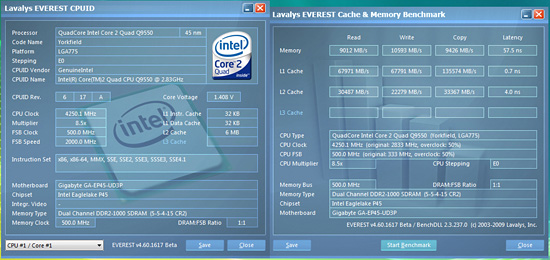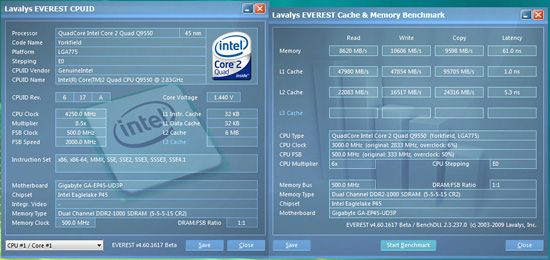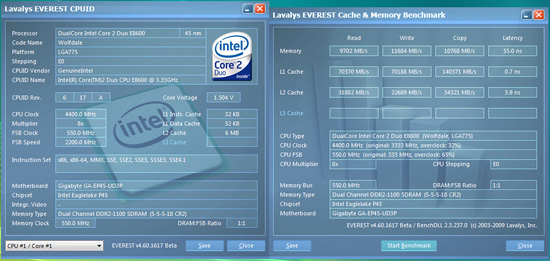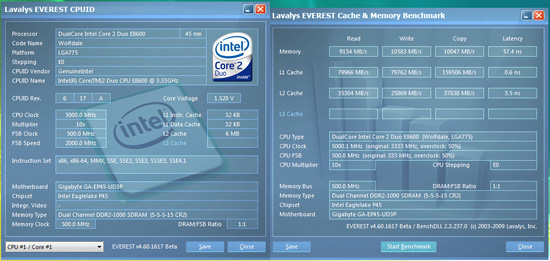Gigabyte GA-EP45-UD3P - P45 at its Finest
by Gary Key on February 3, 2009 12:15 AM EST- Posted in
- Motherboards
Overclocking
GIGABYTE advertises the GA-EP45-UD3P as a mainstream motherboard and will nudge users towards their enthusiast-oriented EP45 Extreme series or X48 boards for overclocking duties. We are here to say that is a big mistake based upon our results. We expected solid overclocking based on the BIOS design and board components, but this board clocked just as well or better than any upper-end P45 or X48 boards we have in the labs.
True, there are boards that might hit higher FSB rates or offer better memory performance, but we are concentrating on mainstream overclocking abilities in our tests. We focus on the type of overclocks that support 24/7 operation with reasonable cooling and the ability to run a multitude of programs without a problem. We are not optimizing for SuperPI or 3DMark records; it's more like trying to keep our bank records safe from a crash (sadly, there's nothing we can do about banks crashing).
We put an emphasis on stability during our testing sessions so we test with real world applications ranging from a variety of games to digital imaging software to various audio/video creation programs, along with the normal OCCT and PCMark Vantage tests.
Q9550 4GB Results

Our maximum overclock on air-cooling with the Q9550 resulted in a 4.25GHz clock speed at a respectable 500MHz FSB with our 4GB G.Skill memory kit set to DDR2-1000 at 5-5-4-15 timings. The primary voltages settings were 1.36V NB, 1.38V VTT, 1.70V PLL, 2.00V VDimm, and 1.425V for the CPU. We tried to run the memory higher, but could not get stability at the DDR2-1200 mark in Nero Recode or Crysis. Vdroop was approximately -.02V with Load Line Calibration (LLC) enabled and -.035V with it disabled at idle. Under load Vdroop was -.025V with LLC enabled and -.05V with it disabled.
Q9550 8GB Results

We were able to reach the same 8.5x500 for a 4.25GHz clock speed with 8GB at DDR2-1000 with 5-5-5-15 timings. However, our voltage settings changed to 1.38V NB, 1.40V VTT, 1.70V PLL, 2.06V VDimm, and 1.450V for the CPU to compensate for the additional load on the MCH. Under load Vdroop was -.02V with LLC enabled and -.05V with it disabled.
E8600 Results

Our maximum overclock on air-cooling with the E8600 came with a blistering 4.40GHz clock speed at a fully stable 550MHz FSB rate. Our 4GB G.Skill memory kit allowed us to reach DDR2-1100 at 5-5-5-18 settings. We used the following voltage settings: 1.40V NB, 1.36V VTT, 1.72V PLL, 2.08V VDimm, and 1.500V for the CPU. We had to drop to 8x500 to get 8GB stable while keeping VDimm below 2.1V, PLL below 1.80V, and NB below 1.50V. Vdroop was approximately -.01V with Load Line Calibration (LLC) enabled and -.025V with it disabled at idle. Under load Vdroop was -.02V with LLC enabled and -.04V with it disabled.
E8600 Additional Results

We knew we had a good E8600, so we pulled out our CoolIT Systems Freezone Elite kit and decided to see how far we could get on this board. We ended up at 5GHz with a 10x CPU multiplier and FSB set to 500. We installed 8GB of memory and ran it at DDR2-1000 with 5-5-5-15 timings. We used the following voltage settings: 1.42V NB, 1.40V VTT, 1.76V PLL, 2.04V VDimm, and 1.5675V (1.550V was stable after raising NB to 1.46V) for the CPU. This is the first time we have reached a stable 5GHz with this processor in a P45 board. Vdroop was similar to our results above.
Thoughts
We have absolutely no concerns about recommending this board for 24/7 500FSB+ use. This board overclocks quad-core chips just as easily as it does dual-core offerings, which is a feat that most P45 boards cannot accomplish. Depending on your processor choice, the Northbridge (MCH) and PLL voltages are two prime settings open for reduction. We only utilize retail processors so it is up to luck if we get a good processor or not for overclocking.
We ultimately ran our E8600 at 585FSB stable in all our applications except for Adobe Premier Pro 4.0; it would constantly hang at any FSB setting above 550. We also tried to verify GIGABYTE’s claim of DDR2-1366 support but our 2GB DDR2-1250 memory kit was unable to get above 1300. However, this is the first board that ran it stable at 1300 so we think it is just a limitation of our memory kit - or reluctance to push more than 2.4V into it.
In regards to voltage regulation, we think the GA-EP45-UD3P has excellent voltage output. We checked all the major voltages with a DMM and found very little variance between what you select in the BIOS and what the board actually outputs. The VTT, PLL, DIMM, and other voltages are accurate and stable across the spectrum. They show no real variances between idle and load states; if anything, we would see a small +.005V rise at times. As discussed, there is line droop on VCore when switching from idle to load situations. However, we found it was not substantial enough to affect stability or overclocking capabilities.
















73 Comments
View All Comments
GhettoFly - Tuesday, February 3, 2009 - link
I'm guessing the 1250 kit you guys managed to clock at 1300 was Corsair's TWIN2X2048-10000C5DF. I have a set of those, but haven't tested with my UD3P yet; however I got my Geil DDR2-1160 C4 kit up to DDR2-1333 C5 on this board with only 2.48V using the 1333 OC profile: http://i4memory.com/f90/gigabyte-ep45-ud3p-memory-...">http://i4memory.com/f90/gigabyte-ep45-ud3p-memory-...This board is too much fun!
Gary Key - Wednesday, February 4, 2009 - link
Yes, it is the Corsair kit and it was an early review sample to boot. Corsair sent us a new SPD and I managed to hit 1333 this morning at 2.50V on it, so I can report that 1333 is stable on this board now after a few runs of Crysis and PCMark Vantage. :)GhettoFly - Wednesday, February 11, 2009 - link
It just seems a bit odd advertising DDR2-1366+ OC capabilities when the ICs needed for such clocks (D9GMH/GKX) are EOL :px86 64 - Sunday, February 15, 2009 - link
I'm still seeing some around and very cheap compared to what they used to be. You can pick up two 2x1GB (4GB) kits of PC2-10400 or PC2-9600 for under $275-$300 US.I think there are third party manufacturers who are still making the D9GMH\GKX, etc, because companies like Cellshock (now recently defunct) and Team Group (active) are still selling both of the most popular flavors of D9. Team is very big in Asia so it's not like they are some small niche company like Cellshock moving a small quantity of old stock. All of Team Group's Xtreem memory (not the "Dark" branding) is either GMH or GKX. How else to explain the constant flow of Micron D9 IC's to certain companies? Could there be that much stock still left over in Asia where they are selling them this long after they were discontinued?? I would be surprised.
GhettoFly - Sunday, February 15, 2009 - link
It has to be old stock of the ICs at least; when you look at the codes on the ICs themselves (not the D9Gxx code, but like 7KD22) I'm pretty sure the first number indicates the year of manufacture, 7 being 2007, 6 being 2006, etc. I haven't see any Micron RevD chips that have those codes staring with 8 even on sticks with a 2008 production date, for example my Geil 1160 C4 and Team Xtreem 9600 kits, the ICs on both have that code starting with a 7.Mr Roboto - Wednesday, February 18, 2009 - link
I don't know what the number is on the IC's themselves but you can check the manufacture date of your memory using a monitoring program like Everest.I have a set of Team's and using Everest they say the 14th week of 2008 as the date or manufacture.
Whether or not the IC's were made then or the modules themselves is debatable.
x86 64 - Sunday, February 15, 2009 - link
I think you might be right. I just pulled the spreaders off my Team 1200Mhz and sure enough it starts with a 7. I hope they don't run out anytime soon because it's so much fun to push this stuff :)It's weird, this has to be the first time in a long time that I'm happy with "last generation" hardware. I just don't see the benefit of i7 and DDR3 right now. I'm enjoying the rock solid P45, excellent inexpensive dual and quad Penryn's and dirt cheap high performance memory. I'd rather buy double the current hardware then spend the same amount for an entry level i7 system and get a 20% increase in performance. I'm sure the i7 will make a great server or HPC but I'm not impressed to much with the desktop parts. We need some multithreaded applications first. Software is seriously lagging.
I'll wait for the die shrink and in the mean time stick with my DDR2 and D9GKX\GMH :)
x86 64 - Sunday, February 15, 2009 - link
Also here's a picture of a TG kit from a review at XBit Labs from the summer of 2007 and it's marked with a 6 which would be in line with the markings on the recent chips, just one year back.http://www.xbitlabs.com/images/memory/team-xtreem/...">http://www.xbitlabs.com/images/memory/team-xtreem/...
GhettoFly - Wednesday, February 18, 2009 - link
Looks like I have to eat my words about no D9 being manufactured in 2008, these are powering the G.Skill 2GBHK sticks I got in today.http://www.xtremesystems.org/forums/showpost.php?p...">http://www.xtremesystems.org/forums/showpost.php?p...
Glenn - Tuesday, February 3, 2009 - link
Great article Gary! I have built approximately 10 systems so far with this board or it's single PCIe X16 twin UD3R, and the "C" version with the DDR3/DDR2 slots. My experiences with each are just as pleasing as you have reported. My own system is the C version with a Q9550 slightly overclocked to 3.4GHz. I am excited to see the followup on the Ultra Durable 3 technology.I am equally or even more excited that you are testing the support of Gigabyte and other manufacturers. I have built over 100 systems using gigabyte P35/G35 and now P45/G45 boards in the past year and a half and I honestly nearly quit using them over some issues with the G45 board when it was first released. It wasn't even close to stable but subsequent bios'es corrected all my complaints. I could get no response from Gigabyte during that time and was pretty pist off! Interestingly enough, I just about switched all my builds to Asus, but I was reminded of past problems with them on my first P45Q build when I went to download the newest drivers! Why does a multibillion dollar company like Asus insist on having a dog-assed slow website that is so painful to negotiate? At times during the day, one can't even get a page to open without timing out! And it's been that way for years! Gigabyte! You owe Asus a "save" on that one! Kudos to Anands crew for taking up these frustrations with the mfgs! Great article!